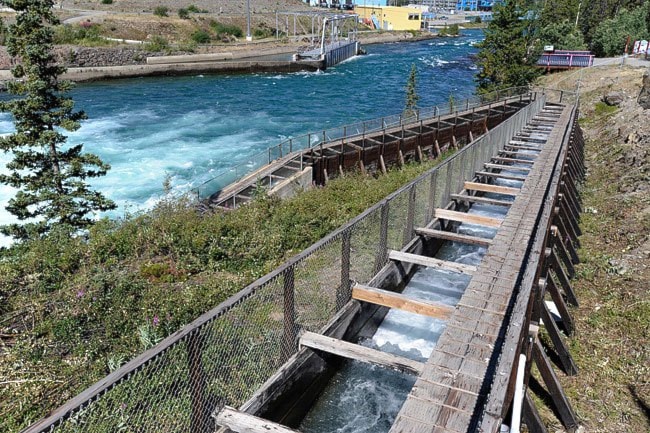This year’s Yukon chinook salmon run could have been the worst on record, despite stricter restrictions on fishing on both sides of the border.
The Yukon River Panel is gathered in Whitehorse this week to review the season and discuss the future of the salmon.
“It’s hard not to get emotional,” said Duane Gastant’ Aucoin, who spoke on behalf of the Teslin Tlingit Council.
Asking First Nations to hold back more than they have been in recent years would be like trying to squeeze blood from a rock, he said.
The Teslin Tlingit used to harvest 1,100 fish in an abundant year, while this year they only took 24, said Aucoin.
He remembers as a young boy being terrified of the giant salmon that his grandmother would pull into the boat, he said. But now, there are hardly any salmon, and the ones that do show up are small.
To the Tlingit people, the salmon are more than food, said Aucoin. They are a people who come to visit every year, to replenish not only the human inhabitants, but the environment itself.
“We all feel the loss of the numbers going down.”
Fishing restrictions on the Alaska side of the border were stricter this year than they have ever been.
Stephanie Schmidt, a research biologist with the Alaska Department of Fish and Game, gave an overview of the U.S. season Tuesday.
Measures were taken to reduce the chinook bycatch in the commercial chum fishery.
When chinook in the river were abundant, fishermen had to leave their gillnets at home and use dipnets or beach seines instead. All chinook had to be immediately released, live.
Gillnets are set across a river and catch fish that run into them by ensnaring their gills, while dipnets are used to scoop fish out of the water by hand, and beach seines are nets used to corral fish from shore.
When the bulk of the chinook run had passed, commercial fishers could bring out the gillnets, but the allowed mesh size was reduced, as well at the allowed depth, to target chum more specifically and allow chinook to get through.
In the end, 484 chinook were caught by the fishery, down from about 1,200 last year, said Schmidt.
The harvest by Alaska native subsistence fishers was curtailed, too.
Chinook typically enter the mouth of the Yukon River in pulses, with more of the fish in the early pulses headed for Canadian waters.
In past years the first pulse of fish has been protected by short-term subsistence closures as those salmon move up the river, allowing more fish to make it to the border.
Last year, the first and second pulses of fish were protected.
And in 2013, for the first time ever, fishing was restricted on the third pulse as well.
The effect of those management decisions are yet to be seen, as harvest numbers have not been finalized.
Many remote communities along the river depend on the fish for food through the winter.
Last year, 26,772 chinook were harvested in Alaskan portions of the Yukon River watershed in subsistence and commercial fisheries.
Yukon First Nations took 2,200 fish.
On this side of the border, First Nations are responsible for managing their own fisheries.
The Department of Fisheries and Oceans works with First Nations to reduce the harvest, instead of regulating the fishing directly, said Mary Ellen Jarvis with DFO.
First Nations used different tools to curtail the harvest, she said.
Some urged their members not to fish at all. Others allowed for short fishing windows, or pulled fish camps out early, she said.
If fewer than 30,000 chinook get to the border, the Department of Fisheries and Oceans would consider shutting down the First Nations fishery altogether.
This has never happened. If it ever does, it could have significant implications, given the established rights of First Nations to harvest fish and manage their own fisheries.
This year came close to that threshold. An estimated 30,725 fish made it to the Eagle sonar station, just below the border.
Under federal treaty, Alaska must allow 42,500 fish to pass into Canadian waters, plus enough to allow for First Nations to share in the harvest. That goal has not been met in five of the last seven years.
The position of the Teslin Tlingit Council is to “shut the river down,” said Aucoin.
Being so far from the mouth of the river, Teslin sees the worst of the effect of over-fishing in the ocean and in lower sections of the river.
The management decisions done to date haven’t been working, said Aucoin.
It’s time to take a break, get together, figure out what’s going on and come up with a new plan, he said.
Contact Jacqueline Ronson at
jronson@yukon-news.com
